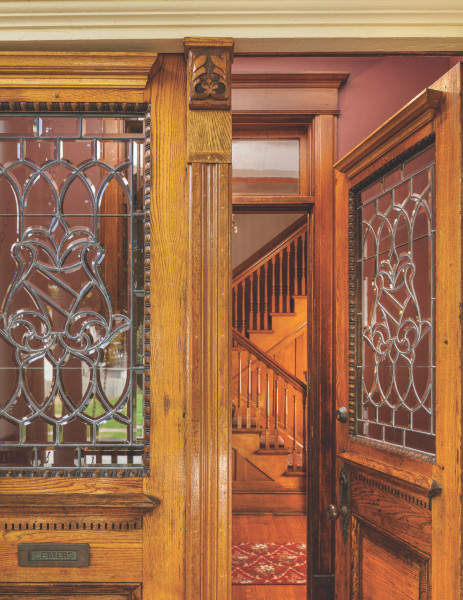
Handsome oak entry doors are period replacements for missing originals; the beveled-glass panels are also salvage and complement those still on the house. Staircase and trim are original.
William Wright
Along with cheap labor, the new mechanical saws and mass manufacture that came with the Industrial Revolution created a burgeoning market for wood embellishment, inside and out. “Gingerbread” was even added to earlier houses, especially when the owners added a new front porch.
The Victorian era’s most common ornaments are still in production: from big wood brackets under the cornice to bull’s-eye corner blocks in window trim. The local millworks usually can closely match any surviving piece you bring in. Choose components cut from durable, insect-resistant, dimensionally stable wood with a low moisture content (kiln-dried poplar, Western red cedar, redwood, mahogany). For elements not at eye level, or in extreme conditions, today’s resin and engineered substitutes are a good option; when they are painted, it’s hard to tell them from wood.
The keys to longevity are good design (including flashing as necessary), non-corroding fasteners, caulk, and paint. Before you install any wood ornament, be sure to prime all surfaces. Add two coats of paint to every exposed surface, and maintain the finish.
Vocabulary of Victorian Millwork
Balustrade A better word than the inexact “banister,” it means the assembly of a top rail, balusters or spindles, and a foot rail or bottom moulding, used on a staircase, balcony, or porch.
Bargeboard The trim piece, carved or pierced or otherwise embellished, fixed to the projecting edges of a gable in the roof. Very popular in Gothic Revival architecture, also common on Queen Anne and Tudor houses.
Bracket A projection from a wall or vertical surface providing structural or visual support under overhangs such as a cornice or balcony. Scroll-sawn wood brackets were popular.
Corner block A square used at corners where mouldings and trim change direction around windows, doors, and mantels, eliminating the need for miter joints. Most common was the bull’s eye, a set of concentric circles, which is still available as stock millwork. Foliate (leaf and flower pattern) blocks were also popular in the Victorian era.
Finial An ornament, usually pointed, atop an architectural element such as a gable or newel.
Fretwork An openwork ornamental design consisting of repeating elements within a band or border. The infill may be designs cut with a scroll saw, or repeated turnings, or ball-and-spindles.
Gingerbread A reference to an excess of applied wood ornament, commonly referencing Gothic Revival and Victorian Queen Anne houses.
Spandrel The triangle formed between an arch and the outside frame. In stairbuilding, the vacant or filled triangle under the stair, and also the triangular ornaments applied to an open stringer where risers meet treads. In historical millwork, the ornament used to span the top of a doorway or bay, and also in corner treatments.
Spindle A slender, lathe-turned element used in a balustrade or as part of decorative fretwork.
Selected Sources:
These companies sell stock and custom Victorian millwork, with many period designs.
Blue Ox Millworks blueoxmill.com
Cumberland Woodcraft cumberlandwoodcraft.com
The Gingerbread Man gingerbreadman.com
Mad River Woodworks madriverwoodworks.com
Pagliacco Turning & Milling pagliacco.com
Vintage Woodworks vintagewoodworks.com
Western Spindle westernspindle.com







